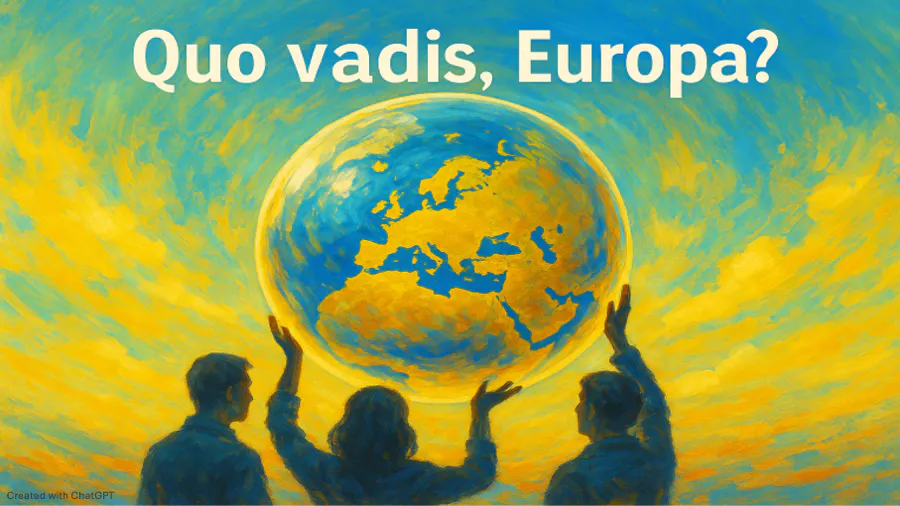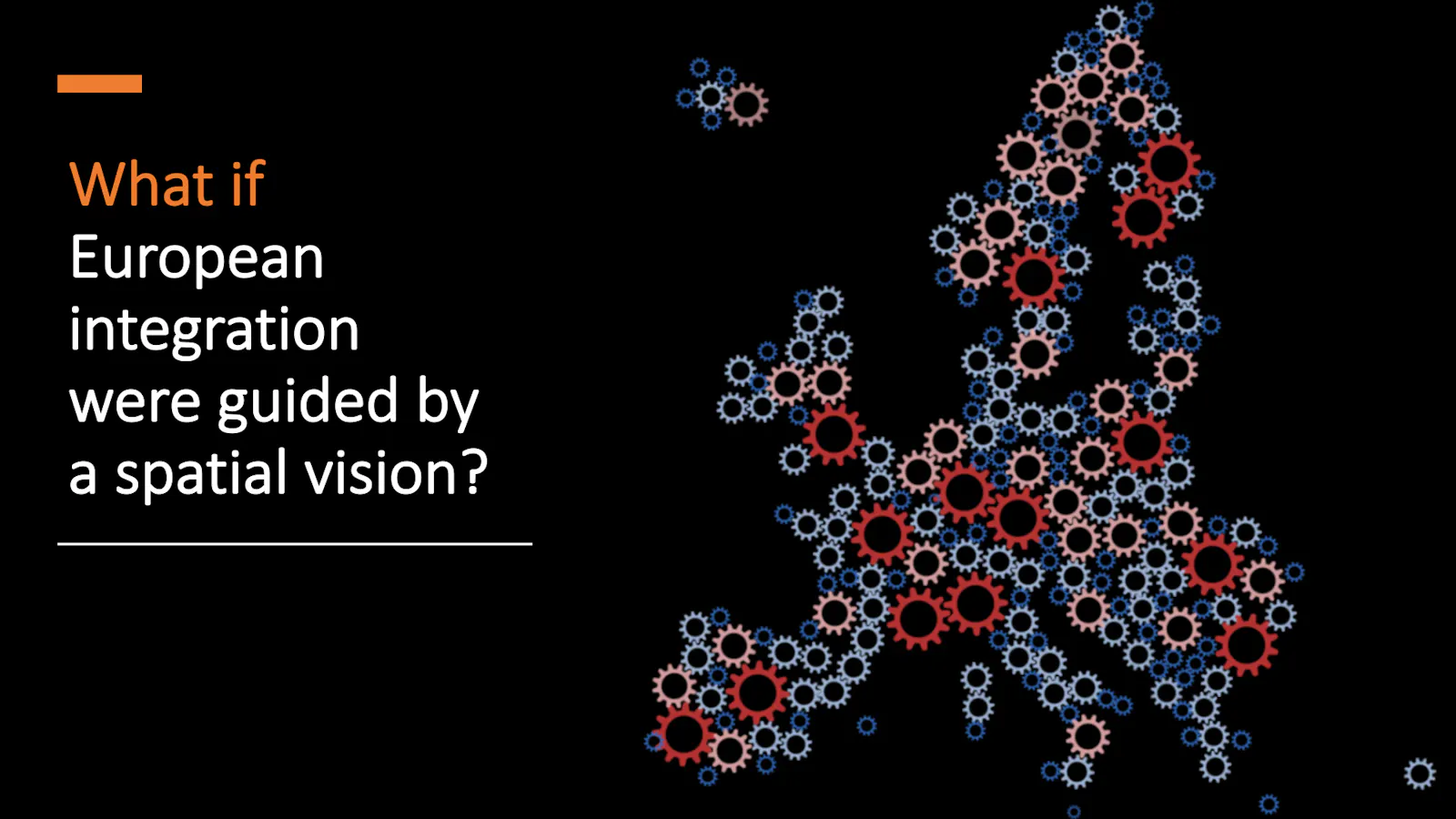Quo vadis, EU?
June 2025

The EU has never stood still. Born out of the ashes of war and division, it has evolved continuously in response to crises, aspirations and the demands of its citizens. However, in recent years, its sense of direction has become increasingly uncertain.
So, let’s take a step back. What does community mean today? What does the Union really stand for? These two words, so central to the genesis of the EU, once evoked a sense of shared purpose, mutual responsibility and collective progress. They signalled a commitment to shaping a shared future grounded in solidarity and common rules. However, today they risk becoming empty labels, divorced from their original meaning.
Instead of contributing to something greater than ourselves, the EU is all too often treated as a source of entitlements to be claimed rather than responsibilities to be shared. We are drifting towards a Union of cherry-pickers – a patchwork of selective engagements where Member States embrace only what suits them while disregarding what binds the Union together.
Examples abound. Some demand access to EU funding but reject the core democratic principles attached to it, such as the separation of powers, freedom of the press and protection of minorities. Others insist on the benefits of Schengen and free movement, yet unilaterally reintroduce border checks or pick and choose whom to admit. Calls for a level playing field in the single market go hand in hand with a race to approve national subsidies that favour domestic firms over fair competition.
This fragmented approach undermines the EU’s integrity and long-term viability. It creates asymmetries, mistrust and diverging expectations. In this context, discussing the future of Europe is not optional – it is essential. We must ask ourselves what kind of Union we want: one that reaffirms shared principles and offers more than transactional bargains, or one that is eroded by contradictions and half-hearted commitments?
Talking about the future is not just about institutional reforms or policy tweaks. It is about the values we want to uphold, the role of Europe in a rapidly changing world, and whether its institutions and citizens can take ownership of the path ahead. Without such dialogue, stagnation is not the only risk; disintegration disguised as pragmatism is too.
This conversation is not just an abstract exercise in foresight. It is a democratic necessity. Citizens across the continent are questioning whether the European project still delivers for them socially, economically and politically. If the EU is to remain meaningful, it must be clear where it is going and why its vision for the future is worth striving for.
Revisiting the 2017 debate on the future of Europe
It seems that Europe once again stands at a crossroads. This is not the first time, and it might be worth looking back a few years. In 2017, the President of the European Commission at the time, Jean-Claude Juncker, launched a White Paper on the Future of Europe marking the 60th anniversary of the Treaties of Rome (read more (Abre numa nova janela)). The paper laid out five scenarios for how the EU27 might change by 2025. These were not detailed plans, but instead offered ideas to get people thinking. The scenarios were intended to start a debate about the EU's future direction at a time marked by Brexit, rising populism, and global uncertainty.
The five 2017 scenarios were:
Carrying on. The EU continues incrementally, addressing crises as they come. It strengthens the single market and encourages cooperation, but lacks bold steps. Pressure for effectiveness grows without major breakthroughs.
Nothing but the Single Market. The EU limits itself to economic functions. Most social, environmental, and migration policies revert to national control. Without shared political ambition, disparities increase, and regulatory competition may emerge.
Those who want more do more. Coalitions of willing countries deepen cooperation in areas like defence or taxation, while others opt out. This ‘multi-speed Europe’ preserves unity but leads to uneven rights and obligations across the Union.
Doing less more efficiently. The EU focuses on key areas like innovation, trade, and security, and steps back from regional development and cohesion. Delivery improves where the EU remains active, but gaps emerge elsewhere.
Doing more together. The most ambitious option: deeper integration in fiscal, social, foreign, and defence policy. A more federal-style Union emerges, but not without challenges of legitimacy and public trust.
While these five scenarios reflected the realities and political atmosphere of 2017, they still resonate today. And yet, they were also limited. As highlighted in a response by the Spatial Foresight team, the scenarios neglected territorial impacts (read more (Abre numa nova janela)).
Looking back, it seems that the EU has taken on features of all five of these scenarios. The Union has made some small changes, shown that it can work together more during emergencies (for example, dealing with a pandemic or energy problems), and at the same time has become more flexible and sometimes divided. Border checks, different levels of cooperation, and varying commitments to the rule of law all point to a Union dealing with different and sometimes conflicting futures at the same time.
Recalling the current challenge of the EU turning into a cherry-picking Union, revisiting the White Paper provides some framework for the basic question we asked before: What kind of Europe do we want, and for whom?
Outlines for possible scenarios today
In light of the debates and developments since 2017, one could argue that the European future is gradually coalescing around two distinct scenarios. Unlike the five-fold branching in Juncker’s White Paper, today’s context invites us to confront a starker choice: a functional free trade zone, or an ever closer political and social union. Both scenarios are plausible, both have supporters – and both demand clarity of purpose.
Just the Single Market. This scenario would redefine the EU primarily as a free trade zone – a common economic space open to EU Member States, EFTA and EEA countries, candidate countries, and potentially the UK. The focus is pragmatic: ensuring the free movement of goods and services, with a commitment to common standards in technical regulation, environmental protection, social minimums, and state aid control. These rules would aim to safeguard the level playing field and avoid distortions in competition. In essence, this is Europe as a functional marketplace. This model may appeal to those seeking economic cooperation without political entanglement. Without a shared sense of purpose, the EU might become little more than a transactional arena, where solidarity, democratic legitimacy, and cohesion play a marginal role.
An Ever-Closer Union. By contrast, the second scenario envisions a European Union that continues to deepen integration across key domains – what one might call the Union of Unions. This includes an Energy Union, a Capital Markets Union, a Research Union, a Defence Union, a Skills and Labour Mobility Union, and a renewed commitment to freedom of movement via a Passport Union, reinforcing Schengen. Programmes like ERASMUS, as well as joint funding mechanisms for innovation and cohesion, would be scaled up as part of a genuine common project. Imagine a citizen working remotely for an employer in another Member State without hurdles in health insurance, pension rights or double taxation. Imagine an SME selling across the Union without drowning in complex VAT regimes or digital compliance headaches. An ever-closer Union would remove these frictions – bringing the Union closer to its citizens by making it work better for them.
In either case, especially the second one, such a project needs a shared vision. A clear idea of what the Union should do and why it is important. It should be about being successful and fair, but also about who we are, feeling safe, and being able to say what we think. And it must be open to different types of people and ways of life. In a time of changing global power, people being tired of democracy, and society breaking down, such a vision would not be a luxury – it would be a necessity.
It should also reflect the fact that the EU is not an isolated island. In light of the rapidly shifting global landscape, the geopolitical context is impossible to ignore. Rising authoritarianism, military aggression at the EU’s borders and intensifying competition over resources and strategic technologies have elevated geopolitics from the background to centre stage. Therefore, the scenarios must not only be viewed through the lens of internal solidarity or economic integration, but also as a response to external pressures demanding unity. These external pressures may paradoxically become a powerful internal driver of cohesion and solidarity, not out of idealism, but out of necessity.
Quo vadis, EU?
Europe has never been short of crossroads, but today’s choice feels more consequential than most. Standing still does not move us forward. In a world of intensifying fragmentation, technological acceleration, and geopolitical volatility, standing still is not an option. We need to have an open dialogue about what we are willing to build together and step by step builds this.
The debate about the future of Europe is not just about institutional design or economic models – it is about the kind of society we want to live in, and the kind of responsibilities we are willing to share.
by Kai Böhme
 (Abre numa nova janela)
(Abre numa nova janela)


